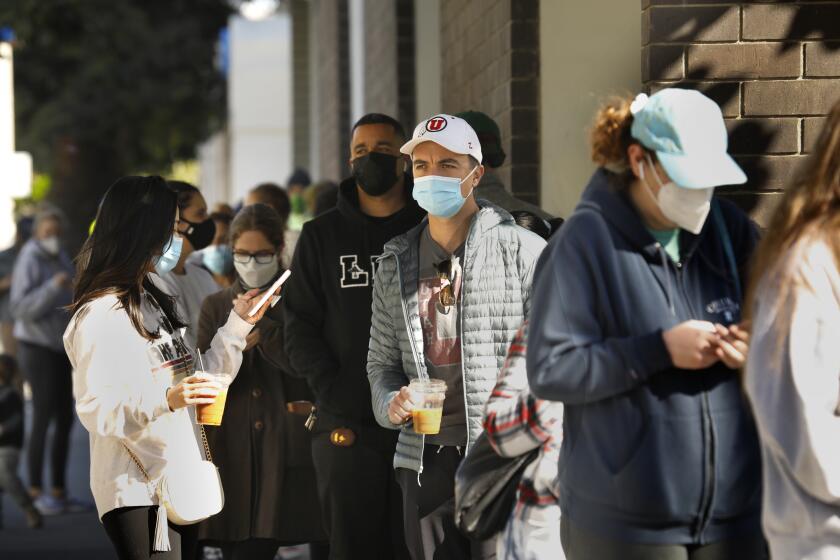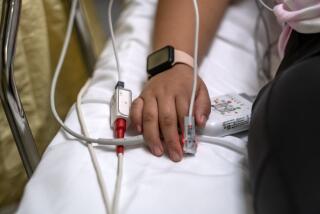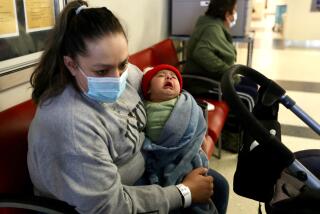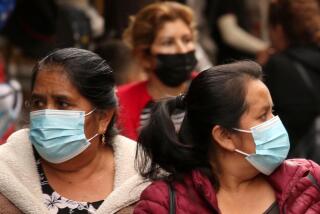L.A. healthcare system hit with widening staffing shortages as workers get coronavirus
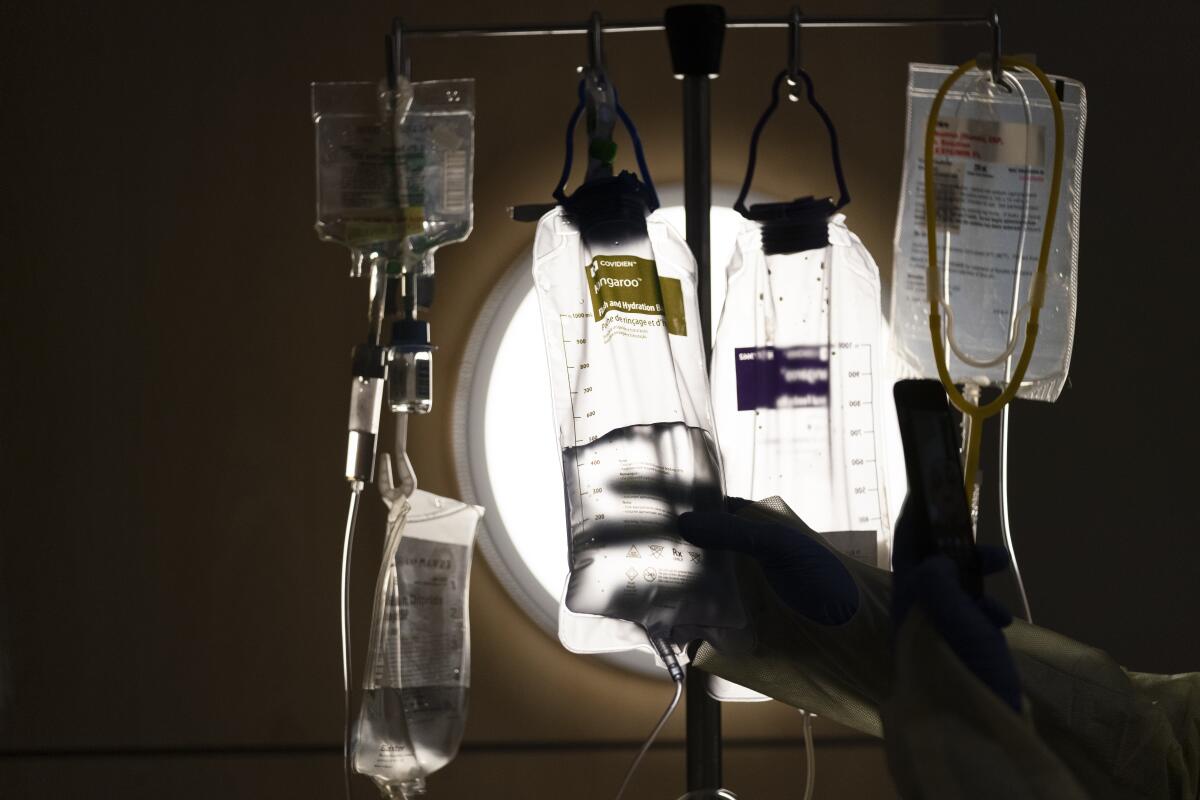
Hospital workers and other healthcare employees have been getting infected with the coronavirus in rising numbers as cases skyrocket in Los Angeles County, compounding staff shortages at medical centers amid the latest wave of the pandemic.
“We have a very sophisticated healthcare system, but it is made up of people,” said Dr. Kimberly Shriner, medical director of infection prevention and control at Huntington Hospital in Pasadena. “And right now, people are getting COVID.”
Roughly 100 front-line workers at the Pasadena hospital are now out because of COVID-19, Shriner said. As cases soar, Huntington has been seeing wait times exceeding five hours at its emergency room. On Tuesday, it started putting elective surgeries on hold.
Staffing shortfalls have pervaded the healthcare system, not just at hospitals and clinics but also “all of the other parts of the healthcare system that need to work in a tightly connected puzzle,” said Dr. Christina Ghaly, director of the L.A. County Department of Health Services.
Dialysis centers that are thin on employees are sending patients to hospitals instead, Ghaly said. Care facilities where DHS-run hospitals would ordinarily send discharged patients are unable to take them in because of staff shortfalls. And ambulances have been delayed getting to 911 callers and face longer waits at hospitals to unload patients, county officials said.
Emergency medical technicians call it “holding the wall” — waiting for a patient to be unloaded from an ambulance. In L.A. County, shortages of hospital staff have led to some ambulances waiting hours to unload patients, which makes them unavailable for other emergency calls.
In cases involving patients with less severe symptoms, “we’ve had ambulances tied up at hospitals up to eight hours over the weekend while patients wait for open beds,” said Jeff Lucia, communications director for the ambulance provider Falck. “To free up ambulances to respond to emergency calls, we’ve brought in camping cots and placed them at some hospitals, but clearly more needs to be done.”
Response times for ambulances, which are supposed to reach people in less than nine minutes, are currently “ranging more at about 12 minutes, with some as long as 30 minutes,” the L.A. County Department of Health Services said Tuesday.
Lucia said that if Falck’s units weren’t tied up at hospitals, they would have enough resources to reach callers quicker. But EMT Ryan Walters, president of the International Assn. of EMTs and Paramedics Local R12-370, called the situation “a predictable outcome of the pandemic and the wages and working conditions of our members.”
Walters, who works in L.A. County for Falck, faulted not only rising COVID-19 cases — Falck said 5% of its workforce in L.A. County is now out for COVID-19 quarantine — but also pay levels and workloads that have made it harder to retain EMTs and paramedics.
Ambulance workers are “just being pushed to the limit,” said James Webb, treasurer for the same union.
The booming numbers of COVID-19 cases in L.A. County have not resulted, so far, in hospitalization numbers as dire as last winter. Health authorities believe that is the result of more people being vaccinated than in earlier waves of the virus, and they have also been hopeful about early signs that Omicron may cause milder illness than other variants.
Healthcare workers in L.A. County are vaccinated at high rates, which makes them much less likely to suffer severe illness and be hospitalized.
But big surges in cases can nonetheless wreak havoc on hospitals if lots of healthcare workers get infected — even with mild cases — and have to stay home to keep others from getting sick.
In L.A. County, the number of hospital workers who have tested positive for COVID-19 began to surge in December, hitting numbers not seen since last January, when the region was emerging from its wintertime surge, county data show.
The rise in coronavirus cases is not unique to healthcare workers but reflects the rapid spread of the highly contagious new variant throughout L.A. County, where the transmission rate has been estimated to be greater than at any point since the early months of the pandemic.
In the week leading up to Christmas, 323 hospital workers in L.A. County tested positive for the virus, along with 426 health workers in other settings, including people working in nursing facilities and first responders — a total of 749 healthcare workers.
That was still well below the wintertime surge a year ago, when more than 2,800 healthcare workers tested positive in a single week. But the latest rise in infections comes as L.A. County hospitals were already raising concerns about staff shortfalls. The Bureau of Labor Statistics has calculated that nationally, employment in the healthcare sector fell by 450,000 between February 2020 and November 2021.
“We’ve been at this now for two years and healthcare workers are fatigued. Exhausted,” said Adam Blackstone, vice president of external affairs and strategic communications for the Hospital Assn. of Southern California. “Many who were approaching retirement age have retired, which has contributed to the workforce shortage.”
Hospitals can try to hire traveling nurses from agencies, but “everybody’s searching in the same pool,” Blackstone said.
Besides having to isolate if they test positive, healthcare workers also have to stay home to care for family members, said Larry Kidd, chief clinical officer at Henry Mayo Newhall Hospital.
“Many hospitals are seeing an increase in COVID infections among children — so parents have to be home to take care of them as well,” Kidd said.
Nurses make up the biggest category among L.A. County healthcare workers and first responders who have tested positive over the course of the pandemic, county data show. Catherine Kennedy, one of the presidents of the California Nurses Assn., said that even before the latest surge, the staffing issues among nurses are “a crisis that the healthcare industry created.”
“Can it be remedied? I think so,” Kennedy said. She argued that hospitals need to improve working conditions and ensure nurses are properly supplied. “Provide us with optimal PPE. Ensure that there’s testing.”
Huntington and some other local hospitals now warn on their websites to expect longer waits at the emergency room. Palms resident Megan Talmadge said she dislocated her elbow in the afternoon on New Year’s Day and waited five hours at a Culver City ER before getting an X-ray. After the X-ray, Talmadge said she asked for medication because “the pain was becoming excruciating.”
“They said, ‘No, sorry, there’s no nurses available,’ and just sent me back out to the waiting room,” Talmadge said.
It took roughly two more hours to get pain medication, Talmadge said. The 30-year-old eventually got a bed, was treated for her injury and left after 1 a.m. — more than nine hours after arriving, she said.
“They were clearly understaffed,” Talmadge said. “There were times when it just seemed like no one was there.”
Shortages also show up in smaller ways: Lisa Berry Blackstock, a private patient advocate, said that in the San Fernando Valley, one of her clients was recently supposed to be moved into a different room closer to the nurses’ station after falling out of bed. When she phoned to confirm the patient had been moved, Blackstock said she was told that “they didn’t have enough staff members to accommodate the transfer.”
At Kaiser Permanente Southern California, swelling demand for coronavirus testing has collided with a shrinking number of staffers to handle them, slowing down turnaround times, said Dr. Nancy Gin, its regional medical director for quality.
California has reported a massive backlog of 237,084 new coronavirus cases, pushing the seven-day average of new infections to 50,267, a record high.
As more of its workers have tested positive for the virus, “it impacts the number of personnel who are available to process the tests,” Gin said. That, combined with “the Great Resignation” of workers both inside and outside the healthcare field, means that “there are not as many individuals who are available, even on a seasonal basis, as there have been in the past,” Gin said.
Testing positive generally means health workers should stay home, although federal and state officials recently cut back the minimum recommended period for many coronavirus-infected people to isolate. The federal move alarmed some public health officials and labor unions, including National Nurses United.
California set out its own recommendations for healthcare workers to go back to work, which differ depending on whether they have gotten booster shots, and permit the isolation period to be truncated if there is a “critical staffing shortage.”
At Cedars-Sinai Medical Center, where nurses are picking up additional shifts and traveling nurses have been hired in anticipation of the surge, the revised rules are expected to help get employees back to work safely, said Dr. Jeff Smith, its chief operating officer.
“We want to make sure we’re doing it appropriately and not putting our staff or our patients at risk,” Smith said. He noted that with the newest variant of the virus, “infectiousness is shown to peak within the first couple days and then drop off relatively rapidly.”
Health officials have urged people without symptoms to not head to the emergency room or urgent care for COVID tests that can be found elsewhere. But Ghaly urged patients not to delay medical care that they need.
Despite the growing pressure on hospitals, her department has surge sites to expand capacity and can call on the state for help with staffing, she said.
“We’re not in a crisis situation in Los Angeles County,” Ghaly said.
Times staff writer Rong-Gong Lin II contributed to this report.
More to Read
Sign up for Essential California
The most important California stories and recommendations in your inbox every morning.
You may occasionally receive promotional content from the Los Angeles Times.
